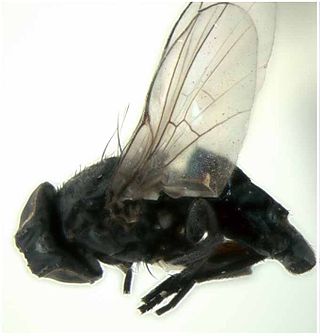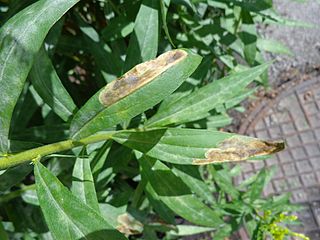
The Agromyzidae are a family of flies, commonly referred to as the leaf-miner flies for the feeding habits of their larvae, most of which are leaf miners on various plants. It includes roughly 2,500 species, they are small, some with wing length of 1 mm. The maximum size is 6.5 mm. Most species are in the range of 2 to 3 mm.

Agromyza is a genus of flies belonging to the family Agromyzidae. The adults of these flies can be recognised by the presence of stridulatory files on the first two abdominal tergites in both males and females. Another useful identifying feature is the halteres which are usually white or yellow, although they are darker in a few tropical species.

Ophiomyia is a genus of flies in the family Agromyzidae.

Agromyza nana is a species of fly in the family Agromyzidae. It is found in the Palearctic. Description of imago-Interocular space red. Antennomeres 1 and II red. Peristoma and palps black. Dorsocentral bristles : 1 +3 subequal; acrostics in four rows. Legs black, knees red. Abdomen black with lighter pruinosity than the thorax. Long.:1,75-2,5 mm. The larva mines Trifolium pratense, Melilotus altissima, Medicago.
Liriomyza sativae, commonly known as the vegetable leaf miner, is a species of insect, a fly in the family Agromyzidae. The larvae of this fly mine the leaves of a range of vegetables and weeds, but seem to favour plants in the families Cucurbitaceae, Fabaceae and Solanaceae.

Liriomyza is a genus of flies in the family Agromyzidae.
Agromyza parvicornis, the corn blotch leafminer, is a species of leaf miner flies in the family Agromyzidae.
Agromyza pudica is a species of leaf miner flies in the family Agromyzidae.
Agromyza ambrosivora is a species of leaf miner fly in the family Agromyzidae.
Agromyza sulfuriceps is a species of leaf miner fly in the family Agromyzidae. It mines leaves from Potentilla plants.
Liriomyza trifolii, known generally as the American serpentine leafminer or celery leafminer, is a species of leaf miner fly in the family Agromyzidae.
Agromyza aristata, the elm agromyzid leafminer, is a species of leaf miner fly in the family Agromyzidae. It is widespread throughout eastern North America, creating leaf mines in Ulmus americana.
Agromyza reptans is a species of leaf miner fly in the family Agromyzidae.
Agromyza isolata is a species of leaf miner flies in the family Agromyzidae.
Ophiomyia coniceps is a species of fly in the family Agromyzidae.

Agromyza albitarsis is a species of leaf miner fly in the family Agromyzidae.
Agromyza diversa is a species of leaf miner flies in the family Agromyzidae.
Agromyza frontella, the alfalfa blotch leafminer, is a species of leaf miner flies in the family Agromyzidae. Larval instars of this species engage in cannibalism.

Agromyza vockerothi is a species of leaf miner fly in the family Agromyzidae, found in North America. The larva of this species feed on brambles (Rubus).

Nemorimyza is a genus of flies in the family Agromyzidae.







